Samsung 750 EVO 500GB SSD Review
Samsung opened up the 750 EVO to the mass market and added a 500GB model, which will allow the company to fight in the low end with a game-changing mix of mainstream performance and entry-level endurance.
Why you can trust Tom's Hardware
Performance And Conclusion
PCMark 8 Real-World Software Performance
For details on our real-world software performance testing, please click here.
Throughput Storage Bandwidth
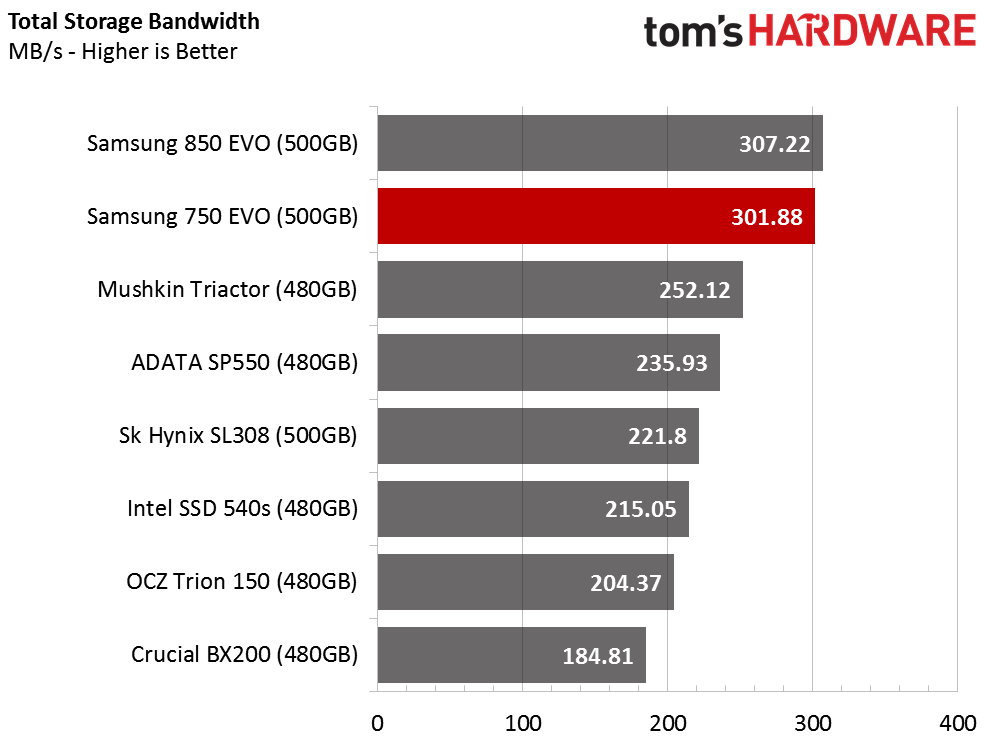
It is very clear that Samsung tried to give the SSD 750 EVO the same performance as the 850 EVO, and it appears to have worked. The two drives offer nearly identical performance with real-world software running in a light-use environment. A user would be hard pressed to tell one EVO from the other during a normal workload.
PCMark 8 Advanced Workload Performance
To learn how we test advanced workload performance, please click here.



We start to see some separation between the two EVO drives with heavier workloads. If you keep the 750 EVO nearly full, it will slow down to a lower level than the 850 EVO, too. The 750 EVO still outperforms the other entry-level SSDs during a light workload by an impressive amount.
Service Time
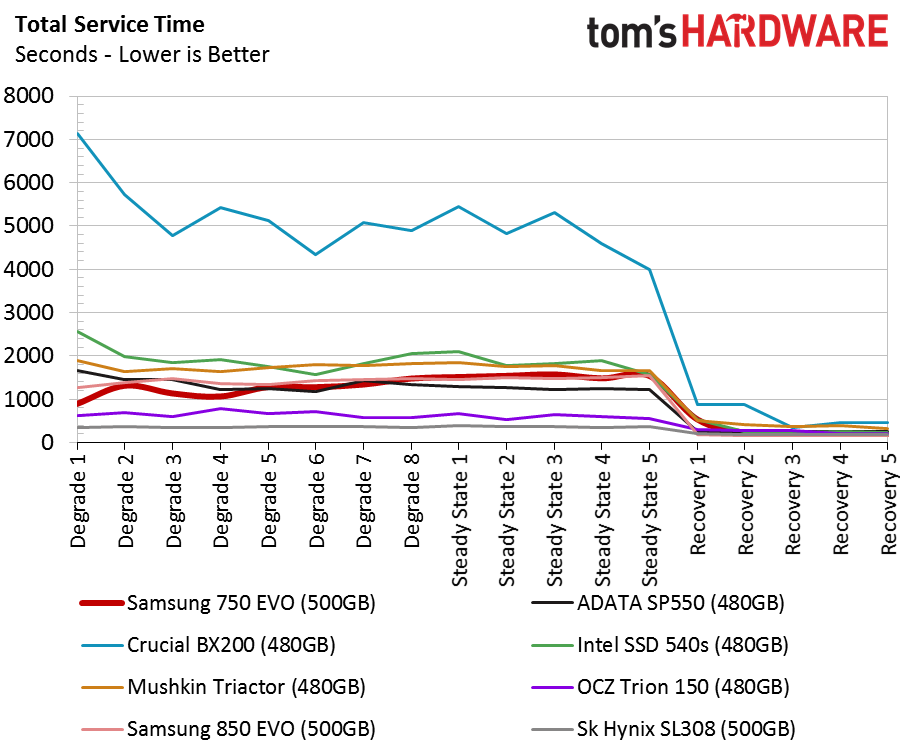

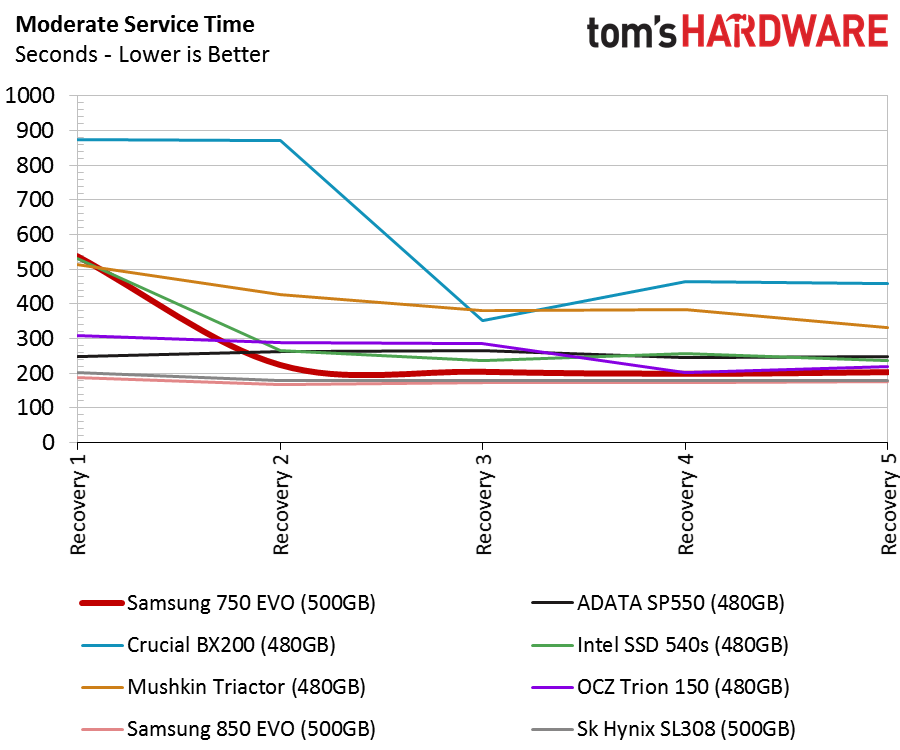
The 750 EVO delivers excellent service times during moderate workloads. The entry-level Samsung 750 comes very close to the same performance as the mainstream 850 EVO during the latency measurements. The SK hynix SL308 turns in a good performance here, too. The other products in the test are less consistent than the 750 EVO.
Notebook Battery Life
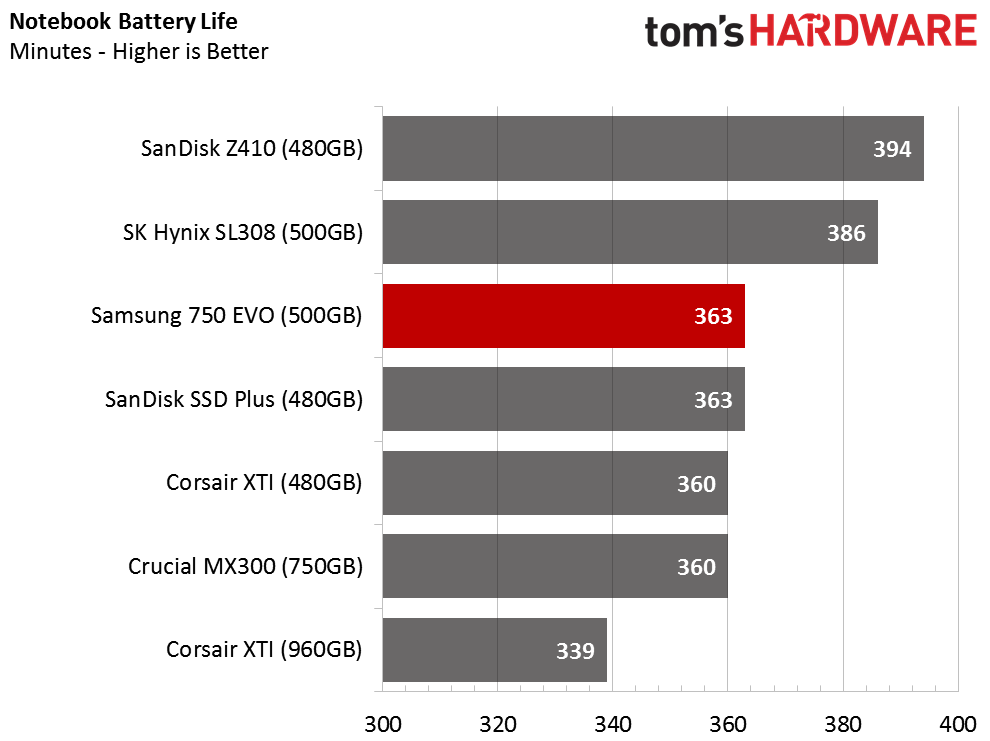
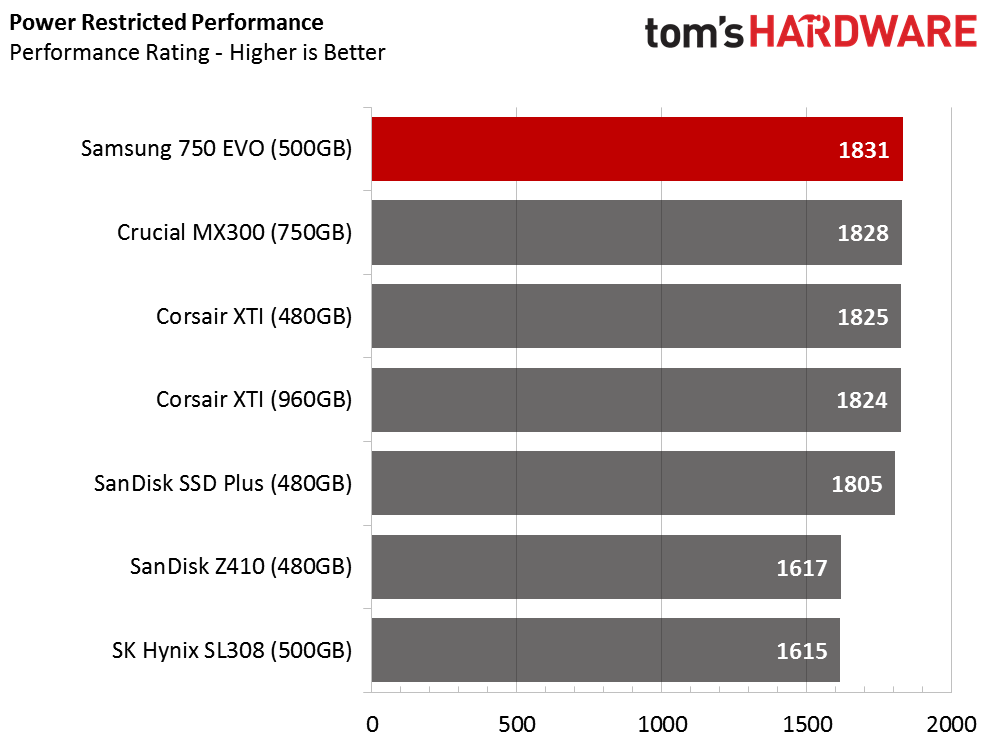
The move to a new Lenovo Y700 17-inch test platform and the latest version of MobileMark 2014 1.5 will take a month to complete, so we are still working through a backlog. We do have several 512GB-class SSDs finished for this review.
We have tested 30 SATA and PCIe NVMe products, and the SSD 750 EVO scores right in the middle of the pack with 363 minutes. For reference, the 850 EVO 1TB with 48-layer V-NAND provided 389 minutes of battery life. Users will get better notebook battery life with the 850 EVO due to its lower-power 3D flash.
MobileMark 2014 increases the focus on system performance in a power-limited environment. SSD performance can vary when the system lowers its performance via clock and bus speeds to reduce power consumption. The 750 EVO does not suffer significant performance losses while under battery power.
Conclusion
Lately, it's been difficult to review SSDs from other manufacturers without discussing Samsung products. Samsung gained more than 50 percent of the SSD market by delivering a superior user experience at a reasonable price point, and that was even before the company gambled with V-NAND. The 3D V-NAND, software, and firmware advances have given the company a real edge over every other SSD on the market today. With the introduction of the 500GB 750 EVO, the entry-level 1TB class is the only segment that Samsung doesn't dominate.

I'm sure that sounds like an Intel, AMD or NVIDIA fanboy-type of statement, but I can assure you I don't like saying it. Competition is good for everyone, and Samsung's dominance means end users have to pay a little more for the company's SSDs. Usually, the difference is only $10 to $20, but regardless, the "Samsung Tax" is there.
The SSD 750 EVO delivers the same performance and user experience as the 850 EVO during normal consumer workloads. The warranty and endurance are the most significant differences between the two SSDs. The 850 EVO has a full 5-year warranty, which covers up to 150 TBW, while the new 750 EVO ships with an entry-level 3-year warranty and 100 TBW. Samsung's 3D V-NAND has a reputation for incredible endurance, as shown in several reports online, but we don't know a lot about the endurance of its new 16nm planar TLC.
The other main differentiator between the two SSDs is performance under heavy write loads. The 850 EVO performs more like a premium SSD under heavy loads, while the new 750 EVO handles like a mainstream SSD during heavy workloads.
I hope that you caught that last line; the Samsung 750 EVO performs like other companies' mainstream SSDs under heavy workloads, which means the drive delivers mainstream performance with a near entry-level price.
There is an MLC flash shortage unfolding, and some companies are stockpiling flash to prepare for holiday production. The industry is transitioning to 3D NAND, but progress is slow, and engineers close to the matter say that some fabs are experiencing poor yields. Apple is not helping the flash situation, as it is buying flash at a high rate as it ramps iPhone 7 production. Other phone manufacturers are also purchasing more flash because new phones will pack more storage capacity, which removes more bits from the market.
The shortage is causing the price of MLC NAND to rise, but it has not affected TLC flash to the same degree. Industry insiders tell us retail SSD prices will level off and end the current free fall, but we are not as confident. The artificially low cost of some SSDs is a product of flash oversupply; the companies lowered the price to sell stockpiled flash. The entry-level and mainstream SSD prices might increase when retailers sell out of the cheap $199 1TB SSDs.
To make this a perfect product, we would like to see a 1TB-class model and an across the board price reduction to compete with the ultra-low price SSDs. Samsung doesn't need to satisfy our demands because most users will pay a small premium for the quality, performance, and features.
MORE: Best SSDs
MORE: How We Test HDDs And SSDs
MORE: All Storage Content
Stay On the Cutting Edge: Get the Tom's Hardware Newsletter
Get Tom's Hardware's best news and in-depth reviews, straight to your inbox.
-
Dark Lord of Tech Bought the 120GB one for a boot drive a couple of months ago , very good performance , well done Samsung.Reply -
hardrock152 Honest (and possibly stupid) question:Reply
The 500 gB version of this costs essentially the same as the 500 gB 850 EVO on amazon. Isn't the 850 Evo a better product, or am I missing something internally (does the TLC flash have some benefit over the 850 EVO)?
Sorry if this is dumb, just kind of curious. -
lucas_7_94 Reply18331527 said:Honest (and possibly stupid) question:
The 500 gB version of this costs essentially the same as the 500 gB 850 EVO on amazon. Isn't the 850 Evo a better product, or am I missing something internally (does the TLC flash have some benefit over the 850 EVO)?
Sorry if this is dumb, just kind of curious.
In a fast view, the only -big- difference i can see is the warranty. 5 years from 850 vs 3 years from 750.
-
jossrik I don't see 170$ for an entry lvl SSD being competetive, if money is an issue, you're going to go with the 100$ 500Gb class SSD over a spinning drive. It's not like there's a fire sale on the 500Gb drives, there are several that are in the 100$ range on the Egg right now, and I just bought a 1TB off the egg with a promo code that cost me 185. Is it a Sammy? No, but will the end user know the difference between it and the Samsung 500Gb? Nope. They will notice the extra 500Gb though. SSDs are reliable enough that under normal use we expect them to last the duration of their warranties and then some, to the point where we don't really worry about Tbs written.Reply -
chalabam It is clearly bottlenecked by SATA.Reply
And since I have no reason to upgrade my mother, the only way that SATA SSD can offer better performance to me is to add multiple SATA cables, and a special driver, to emulate RAID0 with a single drive, or something. -
DynamoNED Priced a little lower, I think the 750 EVO could solidify Samsung's dominance (not necessarily a good thing, BTW). At this price, it's just not worth it over the 850 EVO.Reply -
AndrewJacksonZA Reply
I just paid +-USD112 for a 500GB Samsung 750 EVO yesterday. It's going to replace my 120GB Seagate SSD. Where did you get the price of USD170 from jossrik?18333765 said:I don't see 170$ for an entry lvl SSD being competetive
Yeah, I'm aiming for at least 5 years worth of use out of this drive, hopefully much more. To that end I think I'll only use the first 400GB, maybe 420GB of this drive, I'll try and keep the rest unused. However, this is just me. Does anyone know if now using all of the drive actually increases it's lifespan? I would imagine so since the wear-levelling algorithms have "more" spare space (the unallocated space.) However, wear-levelling algorithms aren't my area of speciality, so I'm just making educated guesses.18333765 said:SSDs are reliable enough that under normal use we expect them to last the duration of their warranties and then some, to the point where we don't really worry about Tbs written.
Can anyone clear this up for me please? -
Onus I just pulled a 250GB Samsung 830 from a system that had become quite balky and was experiencing some data corruption. While not heavily-used the last few years, the drive is probably at least six years old; I'll say I got my money's worth.Reply -
AndrewJacksonZA Thank you Onus, but it can't be that old, Onus! SSDs were first released only a few years ago!Reply
...
Hmmm... a review on 2011/09/24?! 2011?!?!
My, my... It's said that a day might be long but a year is a very short space of time. Do we really appreciate the weight of that statement?
